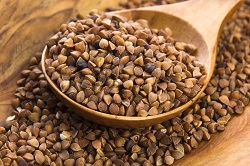Buckwheat is an excellent gluten free option for many grain dishes. Ground into a flour for use in breads, pancakes and other baking or whole as a cereal or rice substitute. Toasted Buckwheat is referred to as Kasha and not suitable for those on a raw food diet.
Buckwheat is also used to make gluten free beer and whiskey.
The hulls are often used as a filling for upholstery including pillows.
Do They Fit My Diet?
- Vegetarian – Yes
- Vegan – Yes
- Raw Vegan – Yes
- Fodmap Friendly – Yes
Buckwheat Benefits
- Versatile
- Gluten Free
- Macrobiotic. Great For Winter Eating
How To Use
- Breads
- Pancakes
- Cereal
- Rice Substitute

